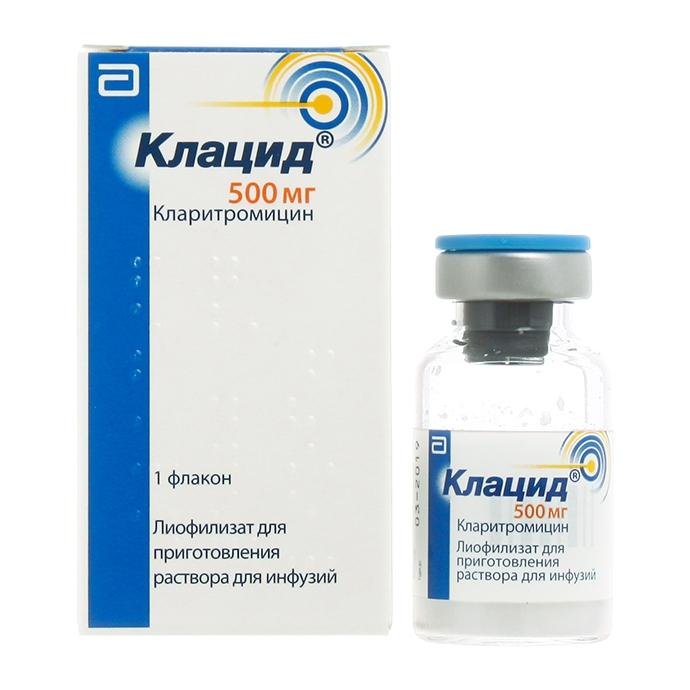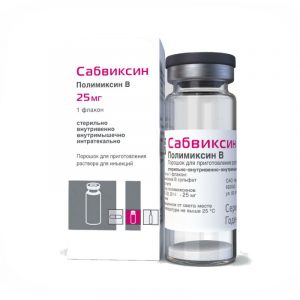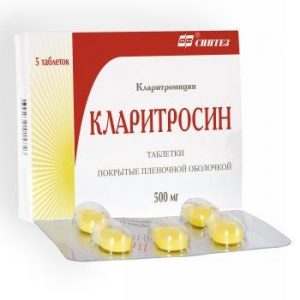Description
Latin name
Klacid
Indications
Infectious and inflammatory diseases caused by microorganisms sensitive to the drug: – upper respiratory tract infections (pharyngitis, tonsillitis and sinusitis)
– lower respiratory tract infections (bronchitis, pneumonia)
– mild otitis sarditis tissues (impetigo, folliculitis, cellulitis, abscesses)
– disseminated or localized mycobacterial infections caused by Mycobacterium avium or Mycobacterium intracellulare
– localized infections caused by Mycobacterium fortuitum, Mycobacterium kansasii, Mycobacterium chelonae.
Contraindications
– severe renal impairment (with CC less than 30 ml / min), fast-release clarithromycin
is prescribed for such patients – simultaneous administration of astemizole, cisapride, pimozide, terfenadine
– porphyria
– pregnancy
– lactation (breastfeeding)
– hypersensitivity to antibiotics of the macrolide group.
Use during pregnancy and lactation
Contraindicated.
Dosage and administration
Injections are prescribed for adults in a daily dose of 1 g divided into 2 injections (500 mg 2 times / day). Each introduction is carried out in / in a drop within 60 minutes. With mycobacterial infections, the dose can be doubled.
In elderly patients, the drug is administered in the same doses as adults.
In patients with severe renal impairment (CC less than 30 ml / min), the dose should be reduced by 50%.
When prescribing Klacid simultaneously with ritonavir in patients with impaired renal function (CC from 30 to 60 ml / min), the dose of clarithromycin should be reduced by 50%, with CC less than 30 ml / min – by 75%. Clarithromycin should not be prescribed in a dose of more than 1 g / day with its simultaneous use with ritonavir.
Intramuscular and intravenous injection of the drug is prohibited!
In / in the drug is administered for 2-5 days, with a possible subsequent transition, if necessary, to take clarithromycin inside. Injections are prescribed to adults in a daily dose of 1 g divided into 2 injections (500 mg 2 times / day). Each introduction is carried out in / in a drop within 60 minutes. With mycobacterial infections, the dose can be doubled.
In elderly patients, the drug is administered in the same doses as adults.
In patients with severe renal impairment (CC less than 30 ml / min), the dose should be reduced by 50%.
When prescribing Klacid simultaneously with ritonavir in patients with impaired renal function (CC from 30 to 60 ml / min), the dose of clarithromycin should be reduced by 50%, with CC less than 30 ml / min – by 75%. Clarithromycin should not be prescribed in a dose of more than 1 g / day with its simultaneous use with ritonavir.
Intramuscular and intravenous injection of the drug is prohibited!
IV drug is administered within 2-5 days, with a possible subsequent transition, if necessary, to take clarithromycin inside.
Side effects of
From the cardiovascular system: rarely – ventricular arrhythmia, including ventricular tachycardia (with an increase in the QT interval).
From the digestive system: nausea, abdominal pain, vomiting, diarrhea, gastralgia, pancreatitis, glossitis, stomatitis, candidiasis of the oral cavity, discoloration of the tongue and teeth rarely – pseudomembranous enterocolitis. Dental discoloration is reversible and is usually restored by professional brushing at the dentist. Dysfunction of the liver was rarely observed, including increased activity of hepatic enzymes, hepatocellular and / or cholestatic hepatitis with or without jaundice. These liver dysfunctions can be severe, but they are usually reversible. Cases of liver failure and death have been very rare, mainly due to severe concomitant diseases and / or concomitant drug therapy.
From the side of the central nervous system: transient headaches, dizziness, anxiety, insomnia, nightmares, tinnitus, depersonalization, hallucinations, cramps, a feeling of fear rarely – psychosis, confusion in some cases – hearing loss (when you stop taking clarithromycin, your hearing returns), a change in smell (usually accompanied by distortions in taste).
Allergic reactions: urticaria, flushing of the skin, pruritus, anaphylaxis, Stevens-Johnson syndrome.
From the hemopoietic system: leukopenia, thrombocytopenia.
On the part of laboratory indicators: an increase in blood creatinine is rare – hypoglycemia (while taking hypoglycemic drugs).
Others: development of microbial resistance.
Drug Interaction
The simultaneous administration of Clacid with cisapride, pimozide and terfenadine is prohibited.
Cross-resistance between Clacid and lincomycin and clindamycin may develop.
Caution is given to clacid concomitantly with lovastatin, simvastatin and other HMG-CoA reductase inhibitors.
With concurrent use of Clacid with drugs that metabolize cytochrome P450 (warfarin, ergot alkaloids, disopyramide, lovastatin, midazolam, rifabutin, triazolam, phenytoin, cyclosporine), there is an increase in the concentration of the latter in the serum.
When Clacid was co-administered with digoxin, theophylline and carbamazepine, an increase in the serum content of the latter was observed.
Overdose
Symptoms: nausea, vomiting, diarrhea.
Treatment: gastric lavage, symptomatic therapy.
Storage conditions
The drug should be stored at room temperature (not higher than 30 ° C).
Expiration
2 years.
Deystvuyuschee substances
clarithromycin
prescription
pharmacy sdfl449 pf7fd4f7 pf7 pf77ff7 pf7f7f1 for all
Prescription
dosage form
dosage form
infusion solution




